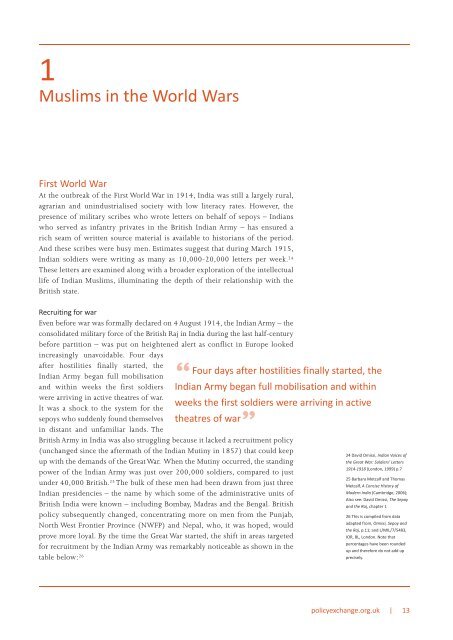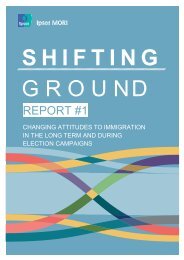Create successful ePaper yourself
Turn your PDF publications into a flip-book with our unique Google optimized e-Paper software.
1<br />
Muslims in the World Wars<br />
First World War<br />
At the outbreak of the First World War in 1914, India was still a largely rural,<br />
agrarian and unindustrialised society with low literacy rates. However, the<br />
presence of military scribes who wrote letters on behalf of <strong>sep</strong>oys – Indians<br />
who served as infantry privates in the British Indian Army – has ensured a<br />
rich seam of written source material is available to historians of the period.<br />
And these scribes were busy men. Estimates suggest <strong>that</strong> during March 1915,<br />
Indian soldiers were writing as many as 10,000-20,000 letters per week. 24<br />
These letters are examined along with a broader exploration of the intellectual<br />
life of Indian Muslims, illuminating the depth of their relationship with the<br />
British state.<br />
Recruiting for war<br />
Even before war was formally declared on 4 August 1914, the Indian Army – the<br />
consolidated military force of the British Raj in India during the last half-century<br />
before partition – was put on heightened alert as conflict in Europe looked<br />
increasingly unavoidable. Four days<br />
after hostili<strong>ties</strong> finally started, the<br />
Indian Army began full mobilisation<br />
and within weeks the first soldiers<br />
were arriving in active theatres of war.<br />
It was a shock to the system for the<br />
<strong>sep</strong>oys who suddenly found themselves<br />
in distant and unfamiliar lands. The<br />
“ Four days after hostili<strong>ties</strong> finally started, the<br />
Indian Army began full mobilisation and within<br />
weeks the first soldiers were arriving in active<br />
theatres of war ”<br />
British Army in India was also struggling because it lacked a recruitment policy<br />
(unchanged since the aftermath of the Indian Mutiny in 1857) <strong>that</strong> could keep<br />
up with the demands of the Great War. When the Mutiny occurred, the standing<br />
power of the Indian Army was just over 200,000 soldiers, compared to just<br />
under 40,000 British. 25 The bulk of these men had been drawn from just three<br />
Indian presidencies – the name by which some of the administrative units of<br />
British India were known – including Bombay, Madras and the Bengal. British<br />
policy subsequently changed, concentrating more on men from the Punjab,<br />
North West Frontier Province (NWFP) and Nepal, who, it was hoped, would<br />
prove more loyal. By the time the Great War started, the shift in areas targeted<br />
for recruitment by the Indian Army was remarkably noticeable as shown in the<br />
table below: 26<br />
24 David Omissi, Indian Voices of<br />
the Great War: Soldiers’ Letters<br />
1914-1918 (London, 1999) p.7<br />
25 Barbara Metcalf and Thomas<br />
Metcalf, A Concise History of<br />
Modern India (Cambridge, 2006);<br />
Also see: David Omissi, The Sepoy<br />
and the Raj, chapter 1<br />
26 This is compiled from data<br />
adapted from, Omissi, Sepoy and<br />
the Raj, p.<strong>11</strong>; and L/MIL/7/5483,<br />
IOR, BL, London. Note <strong>that</strong><br />
percentages have been rounded<br />
up and therefore do not add up<br />
precisely.<br />
policyexchange.org.uk | 13



